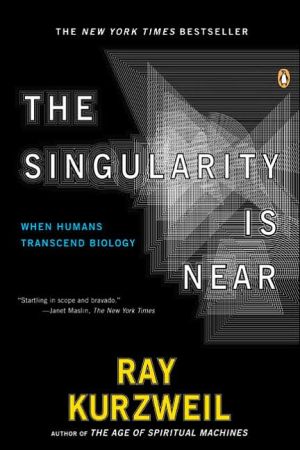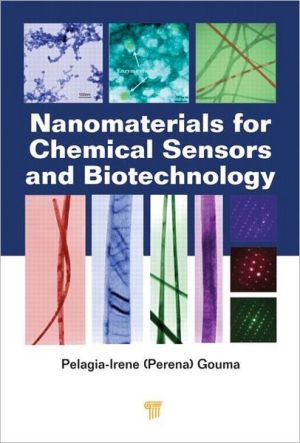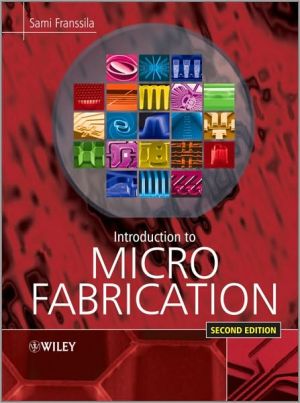Micromechanics and Mems: Classic and Seminal Papers to 1990
Micromechanics is a rich, diverse field that draws on many different disciplines and has potential applications in medicine, electronic interfaces to physical phenomena, military, industrial controls, consumer products, airplanes, microsatellites, and much more. Until now, papers written during the earlier stages of this field have been difficult to retrieve. The papers included in this volume have been thoughtfully arranged by topic, and are accompanied by section introductions written by...
Search in google:
Micromechanics is a rich, diverse field that draws on many different disciplines and has potential applications in medicine, electronic interfaces to physical phenomena, military, industrial controls, consumer products, airplanes, microsatellites, and much more. Until now, papers written during the earlier stages of this field have been difficult to retrieve. The papers included in this volume have been thoughtfully arranged by topic, and are accompanied by section introductions written by renowned expert William Trimmer.
Micromechanics and MEMS\ Classic and Seminal Papers to 1990 \ \ John Wiley & Sons\ ISBN: 0-7803-1085-3 \ \ \ Chapter One\ There's Plenty of Room at the Bottom \ Richard P. Feynman\ I imagine experimental physicists must often look with envy at men like Kamerlingh Onnes, who discovered a field like low temperature, which seems to be bottomless and in which one can go down and down. Such a man is then a leader and has some temporary monopoly in a scientific adventure. Percy Bridgman, in designing a way to obtain-higher pressures, opened up another new field and was able to move into it and to lead us all along. The development of ever higher vacuum was a continuing development of the same kind.\ I would like to describe a field, in which little has been done, but in which an enormous amount can be done in principle. This field is not quite the same as the others in that it will not tell us much of fundamental physics (in the sense of, "What are the strange particles?") but it is more like solid-state physics in the sense that it might tell us much of great interest about the strange phenomena that occur in complex situations. Furthermore, a point that is most important is that it would have an enormous number of technical applications.\ What I want to talk about is the problem of manipulating and controlling things on a small scale.\ As soon as I mention this, people tell me about miniaturization, and how far it has progressed today. They tell me about electric motors that are the size of the nail on your small finger. And there is a device on the market, they tell me, by which you can write the Lord's Prayer on the head of a pin. But that's nothing; that's the most primitive, halting step in the direction I intend to discuss. It is a staggeringly small world that is below. In the year 2000, when they look back at this age, they will wonder why it was not until the year 1960 that anybody began seriously to move in this direction.\ Why cannot we write the entire 24 volumes of the Encyclopaedia Britannica on the head of a pin?\ Let's see what would be involved. The head of a pin is a sixteenth of an inch across. If you magnify it by 25 000 diameters, the area of the head of the pin is then equal to the area of all the pages of the Encyclopaedia Britannica. Therefore, all it is necessary to do is to reduce in size all the writing in the Encyclopaedia by 25 000 times. Is that possible? The resolving power of the eye is about 1/120 of an inch-that is roughly the diameter of one of the little dots on the fine half-tone reproductions in the Encyclopaedia. This, when you demagnify it by 25 000 times, is still 80 angstroms in diameter-32 atoms across, in an ordinary metal. In other words, one of those dots still would contain in its area 1000 atoms. So, each dot can easily be adjusted in size as required by the photoengraving, and there is no question that there is enough room on the head of a pin to put all of the Encyclopaedia Britannica.\ Furthermore, it can be read if it is so written. Let's imagine that it is written in raised letters of metal; that is, where the black is in the Encyclopaedia, we have raised letters of metal that are actually 1 /25 000 of their ordinary size. How would we read it?\ If we had something written in such a way, we could read it using techniques in common use today. (They will undoubtedly find a better way when we do actually have it written, but to make my point conservatively I shall just take techniques we know today.) We would press the metal into a plastic material and make a mold of it, then peel the plastic off very carefully, evaporate silica into the plastic to get a very thin film, then shadow it by evaporating gold at an angle against the silica so that all the little letters will appear clearly, dissolve the plastic away from the silica film, and then look through it with an electron microscope!\ There is no question that if the thing were reduced by 25 000 times in the form of raised letters on the pin, it would be easy for us to read it today. Furthermore, there is no question that we would find it easy to make copies of the master; we would just need to press the same metal plate again into plastic and we would have another copy.\ How Do We Write Small?\ The next question is: How do we write it? We have no standard technique to do this now. But let me argue that it is not as difficult as it first appears to be. We can reverse the lenses of the electron microscope in order to demagnify as well as magnify. A source of ions, sent through the microscope lenses in reverse, could be focused to a very small spot. We could write with that spot like we write in a TV cathode ray oscilloscope, by going across in lines, and having an adjustment which determines the amount of material which is going to be deposited as we scan in lines.\ This method might be very slow because of space charge limitations. There will be more rapid methods. We could first make, perhaps by some photo process, a screen which has holes in it in the form of the letters. Then we would strike an arc behind the holes and draw metallic ions through the holes; then we could again use our system of lenses and make a small image in the form of ions, which would deposit the metal on the pin.\ A simpler way might be this (though I am not sure it would work): We take light and, through an optical microscope running backwards, we focus it onto a very small photoelectric screen. Then electrons come away from the screen where the light is shining. These electrons are focused down in size by the electron microscope lenses to impinge directly upon the surface of the metal. Will such a beam etch away the metal if it is run long enough? I don't know. If it doesn't work for a metal surface, it must be possible to find some surface with which to coat the original pin so that, where the electrons bombard, a change is made which we could recognize later.\ There is no intensity problem in these devices-not what you are used to in magnification, where you have to take a few electrons and spread them over a bigger and bigger screen; it is just the opposite. The light which we get from a page is concentrated onto a very small area so it is very intense. The few electrons which come from the photoelectric screen are demagnified down to a very tiny area so that, again, they are very intense. I don't know why this hasn't been done yet!\ That's the Encyclopaedia Britannica on the head of a pin, but let's consider all the books in the world. The Library of Congress has approximately 9 million volumes; the British Museum Library has 5 million volumes; there are also 5 million volumes in the National Library in France. Undoubtedly there are duplications, so let us say that there are some 24 million volumes of interest in the world.\ What would happen if I print all this down at the scale we have been discussing? How much space would it take? It would take, of course, the area of about a million pinheads because, instead of there being just the 24 volumes of the Encyclopaedia, there are 24 million volumes. The million pinheads can be put in a square of a thousand pins on a side, or an area of about 3 square yards. That is to say, the silica replica with the paper-thin backing of plastic, with which we have made the copies, with all this information, is on an area of approximately the size of 35 pages of the Encyclopaedia. This is only one-fourth as many pages as a copy of the Saturday Evening Post. All of the information which all of mankind has ever recorded in books can be carried around in a pamphlet in your hand-and not written in code, but as a simple reproduction of the original pictures, engravings, and everything else on a small scale without loss of resolution.\ What would our librarian at Caltech say, as she runs all over from one building to another, if I tell her that, ten years from now, all of the information that she is struggling to keep track of-120 000 volumes, stacked from the floor to the ceiling, drawers full of cards, storage rooms full of the older books-can be kept on just one library card! When the University of Brazil, for example, finds that their library is burned, we can send them a copy of every book in our library by striking off a copy from the master plate in a few hours and mailing it in an envelope no bigger or heavier than any other ordinary air mail letter.\ Now, the name of this talk is "There is Plenty of Room at the Bottom"-not just "There is Room at the Bottom." What I have demonstrated is that there is room-that you can decrease the size of things in a practical way. I now want to show that there is plenty of room. I will not now discuss how we are going to do it, but only what is possible in principle-in other words, what is possible according to the laws of physics. I am not inventing antigravity, which is possible someday only if the laws are not what we think. I am telling you what could be done if the laws are what we think; we are not doing it simply because we haven't yet gotten around to it.\ Information on a Small Scale Suppose that, instead of trying to reproduce the pictures and all the information directly in its present form, we write only the information content in a code of dots and dashes, or something like that, to represent the various letters. Each letter represents six or seven "bits" of information; that is, you need only about six or seven dots or dashes for each letter. Now, instead of writing everything, as I did before, on the surface of the head of a pin, I am going to use the interior of the material as well.\ Let us represent a dot by a small spot of one metal, the next dash by an adjacent spot of another metal, and so on. Suppose, to be conservative, that a bit of information is going to require a little cube of atoms 5 × 5 × 5-that is 125 atoms. Perhaps we need a hundred and some odd atoms to make sure that the information is not lost through diffusion, or through some other process.\ I have estimated how many letters there are in the Encyclopaedia, and I have assumed that each of my 24 million books is as big as an Encyclopaedia volume, and have calculated, then, how many bits of information there are (10). For each bit I allow 100 atoms. And it turns out that all of the information that man has carefully accumulated in all the books in the world can be written in this form in a cube of material one two-hundredth of an inch wide-which is the barest piece of dust that can be made out by the human eye. So there is plenty of room at the bottom! Don't tell me about microfilm!\ This fact-that enormous amounts of information can be carried in an exceedingly small space-is, of course, well known to the biologists, and resolves the mystery which existed before we understood all this clearly, of how it could be that, in the tiniest cell, all of the information for the organization of a complex creature such as ourselves can be stored. All this information-whether we have brown eyes, or whether we think at all, or that in the embryo the jawbone should first develop with a little hole in the side so that later a nerve can grow through it-all this information is contained in a very tiny fraction of the cell in the form of long-chain DNA molecules in which approximately 50 atoms are used for one bit of information about the cell.\ If I have written in a code, with 5 × 5 × 5 atoms to a bit, the question is: How could I read it today? The electron microscope is not quite good enough; with the greatest care and effort, it can only resolve about 10 angstroms. I would like to try and impress upon you, while I am talking about all of these things on a small scale, the importance of improving the electron microscope by a hundred times. It is not impossible; it is not against the laws of diffraction of the electron. The wave length of the electron in such a microscope is only 1/20 of an angstrom. So it should be possible to see the individual atoms. What good would it be to see individual atoms distinctly?\ We have friends in other fields-in biology, for instance. We physicists often look at them and say, "You know the reason you fellows are making so little progress?" (Actually I don't know any field where they are making more rapid progress than they are in biology today.) "You should use more mathematics, like we do." They could answer us-but they're polite, so I'll answer for them: "What you should do in order for us to make more rapid progress is to make the electron microscope 100 times better."\ What are the most central and fundamental problems of biology today? They are questions like: What is the sequence of bases in the DNA? What happens when you have a mutation? How is the base order in the DNA connected to the order of amino acids in the protein? What is the structure of the RNA; is it single-chain or doublechain, and how is it related in its order of bases to the DNA? What is the organization of the microsomes? How are proteins synthesized? Where does the RNA go? How does it sit? Where do the proteins sit? Where do the amino acids go in? In photosynthesis, where is the chlorophyll; how is it arranged; where are the carotenoids involved in this thing? What is the system of the conversion of light into chemical energy?\ It is very easy to answer many of these fundamental biological questions; you just look at the thing! You will see the order of bases in the chain; you will see the structure of the microsome. Unfortunately, the present microscope sees at a scale which is just a bit too crude. Make the microscope one hundred times more powerful, and many problems of biology would be made very much easier. I exaggerate, of course, but the biologists would surely be very thankful to you-and they would prefer that to the criticism that they should use more mathematics.\ The theory of chemical processes today is based on theoretical physics. In this sense, physics supplies the foundation of chemistry. But chemistry also has analysis. If you have a strange substance and you want to know what it is, you go through a long and complicated process of chemical analysis. You can analyze almost anything today, so I am a little late with my idea. But if the physicists wanted to, they could also dig under the chemists in the problem of chemical analysis. It would be very easy to make an analysis of any complicated chemical substance; all one would have to do would be to look at it and see where the atoms are. The only trouble is that the electron microscope is one hundred times too poor. (Later, I would like to ask the question: Can the physicists do something about the third problem of chemistry-namely, synthesis? Is there a physical way to synthesize any chemical substance?)\ The reason the electron microscope is so poor is that the ƒ-value of the lenses is only 1 part to 1000; you don't have a big enough numerical aperture. And I know that there are theorems which prove that it is impossible, with axially symmetrical stationary field lenses, to produce an ƒ-value any bigger than so and so; and therefore the resolving power at the present time is at its theoretical maximum. But in every theorem there are assumptions. Why must the field be axially symmetrical? Why must the field be stationary? Can't we have pulsed electron beams in fields moving up along with the electrons? Must the field be symmetrical? I put this out as a challenge: Is there no way to make the electron microscope more powerful?\ The Marvelous Biological System\ The biological example of writing information on a small scale has inspired me to think of something that should be possible. Biology is not simply writing information; it is doing something about it. A biological system can be exceedingly small. Many of the cells are very tiny, but they are very active; they manufacture various substances; they walk around; they wiggle; and they do all kinds of marvelous things-all on a very small scale. Also, they store information. Consider the possibility that we too can make a thing very small, which does what we want-that we can manufacture an object that maneuvers at that level!\ (Continues...)\ \ \ \ \ Excerpted from Micromechanics and MEMS Excerpted by permission.\ All rights reserved. No part of this excerpt may be reproduced or reprinted without permission in writing from the publisher.\ Excerpts are provided by Dial-A-Book Inc. solely for the personal use of visitors to this web site. \ \
Acknowledgments and Dedication.Introduction.Comments on Writing an Article.EARLY PAPERS IN MICROMECHANICS.There's Plenty of Room at the Bottom (R. Feynman).Infinitesimal Machinery (R. Feynman).The Resonant Gate Transistor (H. Nathanson, et al.).Silicon Micromechanical Devices (J. Angell, et al.).Anisotropic Etching of Silicon (K. Bean).Silicon as a Mechanical Materials (K. Petersen).Microrobots and Micromechanical Systems (W. Trimmer).Small Machines, Large Opportunities (K. Gabriel, et al.).SIDE DRIVE ACTUATORS.IC-Processed Electrostatic Micro-Motors (L.-S. Fan, et al.).IC-Processed Micro-Motors: Design, Technology, and Testing (Y.-C. Tai, et al.).Surface-Micromachining Processes for Electrostatic Microactuator Fabrication (T. Lober and R. Howe).A Study of Three Microfabricated Variable-Capacitance Motors (M. Mehregany, et al.).Friction and Wear in Microfabricated Harmonic Side-Drive Motors (M. Mehregany, et al.).Measurements of Electric Micromotor Dynamics (S. Bart, et al.).COMB DRIVE ACTUATORS.Laterally Driven Polysilicon Resonant Microstructures (W. Tang, et al.).Electrostatic-Comb Drive of Lateral Polysilicon Resonators (W. Tang, et al.).Electrostatically Balanced Comb Drive for Controlled Levitation (W. Tang, et al.).Polysilicon Microgripper (C.-J. Kim, et al.).ELECTROSTATIC ACTUATORS.The Principle of an Electrostatic Linear Actuator Manufactured by Silicon Micromachining (H. Fujita and A. Omodaka).Design Considerations for a Practical Electrostatic Micro-Motor (W. Trimmer and K. Gabriel).SCOFSS: A Small Cantilevered Optical Fiber Servo System (J. Wood, etal.).Microactuators for Aligning Optical Fibers (R. Jebens, et al.).Large Displacement Linear Actuator (R. Brennen, et al.).Multi-Layered Electrostatic Film Actuator (S. Egawa and T. Higuchi).Movable Micromachined Silicon Plates With Integrated Position Sensing (M. Allen, et al.).Micro Electro Static Actuator With Three Degrees of Freedom (T. Fukuda and T. Tanaka).The Modelling of Electrostatic Forces in Small Electrostatic Actuators (R. Price. et al.).Silicon Electrostatic Motors (W. Trimmer, et al.).Electrostatic Actuators for Micromechatronics (H. Fujita and A. Omodaka).Electric Micromotors: Electromechanical Characteristics (J. Lang, et al.).Electroquasistatic Induction Micromotors (S. Bart and J. Lang)A Perturbation Method for Calculating the Capacitance of Electrostatic Motors (S. Kumar and D. Cho)MAGNETIC ACTUATORS.Magnetically Levitated Micro-Machines (R. Pelrine and I. Busch-Vishniac).Fabrication and Testing of a Micro Superconducting Actuator Using the Meissner Effect (Y.-K. Kim, et al.).Room Temperature, Open-Loop Levitation of Microdevices Using Diamagnetic Materials (R. Pelrine).HARMONIC MOTORS.An Operational Harmonic Electrostatic Motor (W. Trimmer and R. Jebens).The Wobble Motor: An Electrostatic Planetary-Armature, Microactuator (S. Jacobsen, et al.).An Electrostatic Top Motor and Its Characteristics (M. Sakata, et al.).Operation of Microfabricated Harmonic and Ordinary Side-Drive Motors (M. Mehregany, et al.).OTHER ACTUATORS.Thermal.Micromechanical Silicon Actuators Based on Thermal Expansion Effects (W. Riethmuller, et al.).CMOS Electrothermal Microactuators (M. Parameswaran, et al.).Electrically-Activated, Micromachined Diaphragm Valves (H. Jerman).Study on Micro Engines--Miniaturizing Stirling Engines for Actuators and Heatpumps (N. Nakajima, et al.).Shape Memory Alloy.A Micro Rotary Actuator Using Shape Memory Alloys (K. Gabriel, et al.).Millimeter Size Joint Actuator Using Shape Memory Alloy (K. Kuribayashi).Reversible SMA Actuator for Micron Sized Robot (K. Kuribayashi & M. Yoshitake).Characteristics of Thin-Wire Shape Memory Actuators (P. Neukomm, et al.).Shape Memory Alloy Microactuators (M. Bergamasco, et al.).Impact,Micro Actuators Using Recoil of an Ejected Mass (T. Higuchi, et al.).Precise Positioning Mechanism Utilizing Rapid Deformations of Piezoelectric Elements (T. Higuchi, et al.).Tiny Silent Linear Cybernetic Actuator Driven by Piezoelectric Device With Electromagnetic Clamp (K. Ikuta, et al.).Experimental Model and IC-Process Design of a Nanometer Linear Piezoelectric Stepper Motor (J. Judy, et al.).Piezoelectric.Zinc-Oxide Thin Films for Integrated-Sensor Applications (D. Polla & R. Muller).A Micromachined Manipulator for Submicron Positioning of Optical Fibers (A. Feury, et al.).Ultrasonic Micromotors: Physics and Applications (R. Moroney, et al.).VALVES AND PUMPS.A Microminiature Electric-to-Fluidic Valve (M. Zdeblick & J. Angell).The Fabrication of Integrated Mass Flow Controllers (M. Esashi, et al.).Normally Close Microvalve and Micropump Fabricated on a Silicon Wafer (M. Esashi, et al.).A Thermopneumatic Micropump Based on Micro-Engineering Techniques (F. Van de Pol, et al.).Variable-Flow Micro-Valve Structure Fabricated with Silicon Fusion Bonding (F. Pourahmadi, et al.).A Pressure-Balanced Electrostatically-Actuated Microvalve (M. Huff, et al.).Micromachined Silicon Microvalve (T. Ohnstein, et al.).FLUIDICS.Microminiature Fluidic Amplifier (M. Zdeblick, et al.).A Planar Air Levitated Electrostatic Actuator System (K. Pister, et al.).Liquid and Gas Transport in Small Channels (J. Pfahler, et al.).Squeeze-Film Damping in Solid-State Accelerometers (J. Starr).A Micromachined Floating-Element Shear Sensor (M. Schmidt, et al.).A Multi-Element Monolithic Mass Flowmeter with On-Chip CMOS Readout Electronics (E. Yoon & K. Wise).Environmentally Rugged, Wide Dynamic Range Microstructure Airflow Sensor (T. Ohnstein, et al.).SURFACE MICROMACHINING.Polycrystalline Silicon Micromechanical Beams (R. Howe & R. Muller).Integrate Fabrication of Polysilicon Mechanisms (M. Mehregany, et al.).Integrated Movable MicroMechanical Structures for Sensors and Actuators (L.-S. Fan, et al.).Polysilicon Microbridge Fabrication Using Standard CMOS Technology (M. Parameswaran, et al.).Process Integration for Active Polysilicon Resonant Microstructures (M. Putty, et al.).Fabrication of Micromechanical Devices From Polysilicon Films With Smooth Surfaces (H. Guckel, et al.).Selective Chemical Vapor Deposition of Tungsten for Microelectromechanical Structures (N. MacDonald, et al.).BULK MICROMACHINING.Fabrication of Hemispherical Structures Using Semiconductor Technology for Use in Thermonuclear Fusion Research (K. Wise, et al.).Micromachining of Silicon Mechanical Structures (G. Kaminsky).Strings, Loops, and Pyramids--Building Blocks for Microstructrures (H. Busta, et al.).Corner Compensation Structures for (110) Oriented Silicon (D. Ciarlo).A Study on Compensating Corner Undercutting in Anisotropic Etching of (100) Silicon (X.-P. Wu & W. Ko).A New Silicon-on-Glass Process for Integrated Sensors (L. Spangler and K. Wise).Mechanisms of Anodic Bonding of Silicon to Pyrex(r) Glass (K. Albaugh, et al.).Silicon Fusion Bonding for Pressure Sensors (K. Petersen, et al.).Low-Temperature Silicon-to-silicon Anodic Bonding With Intermediate Low Melting Point Glass (M. Esashi, et al.).Fusing Silicon Wafers With Low Melting Temperature Glass (L. Field & R. Muller).Silicon Fusion Bonding for Fabrication of Sensors, Actuators and Microstructures (P. Barth).Scaling and Dielectric Stress Compensation of Ultrasensitive Boron-Doped Silicon Microstructures (S. Cho, et al.).Field Oxide Microbridges, Cantilever Beams, Coils and Suspended Membranes in SACMOS Technology (D. Moser, et al.).Micromachining of Quartz and its Application to an Acceleration Sensor (J. Daniel, et al.).LIGA.Fabrication of Microstructures using the LIGA Process (W. Ehrfeld, et al.).Deep X-Ray and UV Lithographies for Micromechanics (H. Guckel, et al.).COMPUTER AIDED DESIGN.OYSTER, a 3D Structural Simulator for Micro Electromechanical Design (G. Koppelman).A CAD Architecture for Microelectromechanical Systems (F. Maseeh, et al.).CAEMEMS: An Integrated Computer-Aided Engineering Workbench for Micro-Electro-Mechanical Systems (S. Crary and Y. Zhang).CAD for Silicon Anistropic Etching (R. Buser and N. de Rooij).METROLOGY.Can We Design Microbotic Devices Without Knowing the Mechanical Properties of Materials? (S. Senturia).The Use of Micromachined Structure for the Measurement of Mechanical Properties and Adhesion of Thin Films (M. Mehregany, et al.).Mechanical Property Measurement of Thin Films Using Load-Deflection of Composite Rectangular Membrane (O. Tabata, et al.).Fracture Toughness Characterization of Brittle Thin Films (L. Fan, et al.).Spiral Microstructures for the Measurement of Average Strain Gradients in Thin Films (L.-S. Fan, et al.).Polysilicon Microstructures to Characterize Static Friction (M. Lim, et al.).Study of the Dynamic Force/Acceleration Measurement (A. Umeda and K. Ueda).Anomalous Emissivity from Periodic Micro Machined Silicon Surfaces (P. Hesketh, et al.).Author Index.Subject Index.About the Author.Editor's Notes on the Second Printing.








